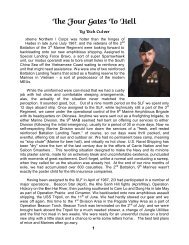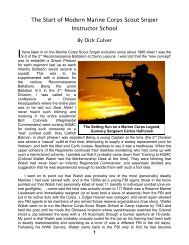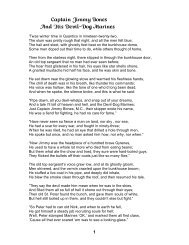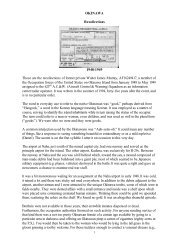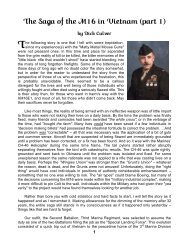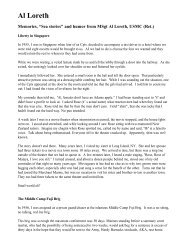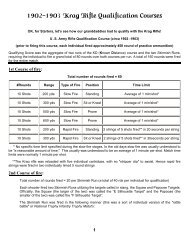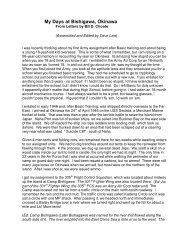Okinawa Bishagawa Kinser Photo Captions - Rohrer, Bob Rohrer
Okinawa Bishagawa Kinser Photo Captions - Rohrer, Bob Rohrer
Okinawa Bishagawa Kinser Photo Captions - Rohrer, Bob Rohrer
You also want an ePaper? Increase the reach of your titles
YUMPU automatically turns print PDFs into web optimized ePapers that Google loves.
CAMP BISHAGAWA & Old CAMP KINSER<br />
OKINAWA<br />
1958 – 1959<br />
1. We were only at Pendleton a month when we shipped out for the Far East on September 15,<br />
1958, aboard the U.S.S. General A. E. Anderson, T-AP 111. This P-2 ship was commissioned<br />
October 5, 1943 and had three battle ribbons for service in the American, European and Pacific<br />
Theaters. In WWII she was configured to carry 5,300 troops, and had sufficient power and<br />
armament to eliminate the need of operating with a convoy. She had a length of 623 feet, a beam<br />
of 76 feet, a weight of 19,700 long tons and a cruising speed of 19 knots. Even at this size, she<br />
shuddered in the typhoon we went through north of Midway.<br />
Before “Secure Deck” was announced, I was forward watching the entire bow plunge below the<br />
water line, with over spray drenching everyone, even 623’ to the stern! This was my first trip<br />
across the Pacific, and it was only when we got to Yokohama, and I looked up from the pier and<br />
saw how high the bow was, that I realized what I had witnessed. I had missed this perspective in<br />
San Diego because the “Cattle Cars” had delivered us directly to a boarding point at mid ship.<br />
Anyway, when the “secure” announcement was made, I moved aft above deck. The last sight I<br />
saw before going below was a sailor in a yellow rain suit strapped to the manual steering wheel. I<br />
asked someone what he was doing and was told: “He is the emergency back up in case we loose<br />
steam steering. It will be his job to keep us headed into the storm so we don’t capsize”. Oh, good<br />
for him! A new friend and former Anderson crew member tells me when the screws come out of<br />
the water and start fanning and vibrating in the air you know the bow is a few fathoms under. We<br />
were birthed aft and I heard the screws doing this all night.<br />
Later, as we sailed up Tokyo Bay, there was a British heavy cruiser anchored not far away and<br />
some Marine shouted out “F**k the Queen”. What a scene! Next, was seeing Japan for the first<br />
time. Wow! The next morning I had guard duty 4 to 8 and saw the famous “Land of the Rising<br />
Sun” in all it’s glory, as the 12,389’ snow-capped peak of Mt. Fuji turned pink in the sunrise. As we<br />
sailed south to <strong>Okinawa</strong> later that day, I will never forget all the small islands with my first sight of<br />
smoking volcanoes. These memories are priceless to me.<br />
I still have the Souvenir Edition of the ships newsletter “Crows Nest” which advised: “This cruise,<br />
Voyage no.122, will be the last for the ANDERSON. At the completion of her present journey,<br />
which will take her to Japan, <strong>Okinawa</strong>, Formosa and Korea, the ANDERSON will return to the<br />
United States for deactivation, leaving behind her an envious record of service.”<br />
2. Domain of the Golden Dragon. I have never been south of the equator but it was neat to get this<br />
certificate for my first crossing of the International Date Line.<br />
3. This was our greeting upon arrival to the little Island of <strong>Okinawa</strong>, the welcome sign on the dock<br />
at Naha.<br />
4. Seven lieutenants from 3/3 stationed at Camp <strong>Bishagawa</strong>, <strong>Okinawa</strong> on board USS Thetis Bay<br />
(LPH-6), following a training exercise in Japan in the spring of 1959. (Clockwise from bottom left)<br />
Lts John Bowles IV, Phil Carletti, Ron Hankin, Robert Modrzejewski, Culler, Belizzi and Howard<br />
Lee. Later, as Captains, two of them Modrzejewski (seated on the top right his with his left arm<br />
down) and Lee (seated center bottom), would be awarded the Medal of Honor for actions in<br />
Vietnam occurring less than one month apart in1966. <strong>Photo</strong> Courtesy of Lt Colonel James Ingram<br />
USMC (Ret) and Leatherneck magazine.
India Company, 3 rd Battalion, 3 rd Marines 3 rd Marine Division, (FMF)<br />
1957 – 1958<br />
5. This company photo immediately preceded our tour. Tom Gray (deceased) is the Guidon and<br />
Jack Helms is third row from the top, 6 in from the left. Taken at Sukiran, shortly after their unit<br />
arrived on <strong>Okinawa</strong> and a month or so before they moved to <strong>Bishagawa</strong>. About 7 months into their<br />
tour they were deployed to Lebanon for a month and returned to Subic Bay, Philippines to build<br />
Camp Driftwood. They remained on 4-hour standby in this tent camp pending further problems in<br />
Lebanon. After a month they returned to <strong>Bishagawa</strong> for the remainder of their tour.<br />
India Company, 3 rd Battalion, 3 rd Marines, 3 rd Marine Division, (FMF)<br />
1958 – 1959<br />
6. This Company photo was taken at Camp <strong>Bishagawa</strong>, <strong>Okinawa</strong> in 1958. I am in the top row sixth<br />
from the left. To my right is Cpl. Al Loreth, our 3.5 rocket section leader. Al remained in the Corps<br />
for 26 years with three tours in Vietnam, and was one of the most Marines’ Marine I ever met. He<br />
is now a retired Master Sergeant; living in Colorado Springs, CO. Al was an important influence on<br />
me even though he did not know it at the time. We are now in regular contact and you can read<br />
his “Sea Stories” in my Friends section.<br />
7. Weapons Platoon, Camp <strong>Bishagawa</strong>, <strong>Okinawa</strong>. Every time I look at this photo, I am surprised<br />
we did not take the BFA’s off the machine guns. They look so “Hollywood” this way! I am in the top<br />
row, second from the left. Cpl. Al Loreth is in the front row, second from the right. My two best<br />
friends, Milford M. “Mick” Putterbaugh is just behind Al in the second row, second from the right;<br />
and Stephen L. Niebur is in the third row, third from the right. Read more about them in my<br />
Friends section.<br />
8. Looking up the entrance hill to Camp <strong>Bishagawa</strong> in 1947 – 1948. In those days they spelled it<br />
Bishigawa with an “i” instead of an “a”. On my <strong>Okinawa</strong> page there are links to several stories of<br />
old <strong>Okinawa</strong> and Bishigawa, along with a current update. Dave Law, a former member of the<br />
USAF Air Defense Control Center at Kadena, was instrumental in helping organize these<br />
references. Dave lived near Kadena Circle and was an S2 Inspector with the US Army. He made<br />
frequent visits to the Yomitan radar station near <strong>Bishagawa</strong>.<br />
9. This is what the main road entrance signs looked like in 1958. The Marine is Master Gunnery<br />
Sergeant Jim Bogue, USMC (Ret) 1958 – 1983. He was then a PFC and a jeep driver at Battalion<br />
Headquarters.<br />
10. The Camp <strong>Bishagawa</strong> main gate at the top of the hill. Note the Marine MP in a helmet and the<br />
<strong>Okinawa</strong>n Security guard in a pith helmet. Great photo courtesy of Jack Helms.<br />
11. Here is a view up to the entrance. I had long wondered if <strong>Bishagawa</strong> was still there. Check the<br />
link on the <strong>Okinawa</strong> page for a 2004 update. One thing you will learn is old <strong>Bishagawa</strong> is now an<br />
Air Force sentry dog training area. I will never forget walking by a dependant swimming pool at<br />
KAB and reading a sign on the entrance that read “No Dogs or Marines allowed”. And now, to top<br />
that, they have let our base “Go to the dogs”! <strong>Photo</strong> courtesy of Dave Law 623 rd AC&W.<br />
12. Looking through the fence to where our camp once was. You came up a hill from the main<br />
road and then down this slight grade into a “plain” surrounded by small hills. Our camp was built in<br />
this “bowl”. Again check the 2004 <strong>Bishagawa</strong> update. <strong>Photo</strong> courtesy of Dave Law 623 rd AC&W.
13. I once had a sign that said “Blessed are they who run around in circles for they shall be known<br />
as Wheels.” When Jack Helms was with I/3/3 they had a colorful guidon dedicated to the<br />
Philleleaux. Their joke was the Philleleaux was supposed to be a bird that flew in ever decreasing<br />
circles at an ever increasing rate of speed until it flew up its own asshole.<br />
Another story is the French are supposed to have presented the Philleleaux to I/3/3 either during<br />
or at the end of WW1. The rocking chair symbolized the unit had fought so long and hard they<br />
should rest and relax and not have to sit on the ground. At least that is what the 1st/Sgt. told<br />
Guidon Tom Gray when he started carrying the Company Colors.<br />
14. Arriving at our area of Camp <strong>Bishagawa</strong> with the I/3/3 office straight ahead. I clearly remember<br />
thinking this is sure a nice staging area, I wonder where the base is. Still makes me laugh. I was<br />
an 0331 so I knew my destiny. All the way over on the ship all I heard was: I’m a cook; I’m in the<br />
air wing; I’m in artillery; I’m in the motor pool etc. etc. etc. On arrival the Company Gunnery<br />
Sergeant fell us out and announced “There has been some MOS confusion”. All my friends were<br />
looking around and smiling at me, like see, I told you so. Then the Gunny says “All of you who<br />
have an MOS other than 0300 take one pace forward…Hugh” “You are now all 0300, take one<br />
pace back…Hugh” So now we were ALL officially in the infantry with I/3/3. Now I smiled back!<br />
15. A closer shot of the I/3/3 office. In the background you can also see the roof of our first “digs”,<br />
which Al Loreth now informs me was an old Kadena Air Force Base storage building. Those of<br />
you who ever went to Kadena Air Base or Sukiran know the Air Force and the Army did not live in<br />
storage buildings!<br />
16. A shot from “School Hill” over looking Camp <strong>Bishagawa</strong>. My note on the back of the photo<br />
says “T-130 our hut.” At this point we had already lived in the large storage building and a “hut” to<br />
the left of this one. This was our last “home” before we moved to Camp <strong>Kinser</strong>. Jack Helms<br />
home, T-120 is the first hut on the right.<br />
17. A face on view of our last quarters. I somehow never noticed the garbage in our “front yard.”<br />
18. How well do you remember your first shower at <strong>Bishagawa</strong>? NO HOT WATER! Our first<br />
surprise was, this IS the base, and now this! Almost a year of ice cold showers before <strong>Kinser</strong>. I am<br />
not sure which was worse, the cold water, or the naked 100-yard run in the cold, rainy winter.<br />
19. The latrine was another nice view from our front door. Remember the “Base Legend” that<br />
Habu snakes lived in these pits and had crawled up the ass of some poor Marine. I now think this<br />
was a way to keep the small place available for a whole Company – no lingering.<br />
20. “Fall Out” for Inspection Arms. Weapons inspection was a big deal and we all feared a loss of<br />
liberty for smallest piece of dirt. And Rust! The only thing worse than a speck of rust would have<br />
been syphilis. Many of us used to carry a small paintbrush for dusting off particles right up to the<br />
last minute. Also, soling the butt plate on the deck was a “no, no”, especially if it was wet. No point<br />
in losing a weekend pass for a dirty butt plate. When I had a rifle, I used to rest mine on my boot<br />
until the last minute and then hold it off the deck at order arms until inspected. By this time I was in<br />
weapons and carried a .45 so cleaning a rifle was no longer my problem. Note the India Company<br />
office in the background. <strong>Photo</strong> courtesy of Jack Helms.<br />
21. “Move Out” was a common command and here is a great shot of India Company in formation<br />
along our short Company Street. We used to run 3.5 rocket drill on the hill up behind the basket<br />
ball court to the right. The main entrance road was straight ahead where the “Cattle Cars” lined up<br />
for pick-up. A formation like this would either be going to the Northern Training Area (NTA), or
White Beach for embarkation on an amphibious exercise. The field transport packs and duffel<br />
bags suggest a longer tour than NTA -- in this case the destination was Lebanon. <strong>Photo</strong> courtesy<br />
of Jack Helms.<br />
During the “Cold War”, the 3rdMarDiv was the “Tip of the Spear” in Asia. We were the ready force,<br />
set to go anywhere, any time. In 1959, North Vietnam initiated its long-term campaign of political<br />
subversion and armed action aimed at destroying the government of South Vietnam. The goal<br />
was to unify Vietnam under the leadership of Ho Chi Minh. To achieve this end, the North<br />
Vietnamese directed Communist guerrillas in the South to spark unrest. They then started a<br />
logistical line of communication and supply through neighboring Laos. This was soon labeled the<br />
Ho Chi Minh Trail. To ease threats to this system, the North Vietnamese exacerbated existing<br />
political tensions in Laos, by supporting the indigenous Pathet Lao Communists, who were<br />
attempting to overthrow the pro-Western Royal Laotian Government.<br />
The United States was determined to oppose these actions. The means adopted was a show of<br />
force by the Seventh Fleet. During September 1959, we deployed to the South China Sea on the<br />
USS Bexar with a multiship, carrier task force as a deterrent to further Communist guerrilla attacks<br />
on pro-American forces in Laos. The Pathet Lao and North Vietnamese supporting forces<br />
withdrew and our presence delayed the ultimate Confrontation in Vietnam. Back on <strong>Okinawa</strong>, we<br />
spent the balance of our tour on 4 hour alert. This required everything be packed in our sea bags<br />
for storage with a field transport pack hung on our rack, ready for immediate departure. The worst<br />
part was the “Cinderella” liberty. No more over nights – back by midnight!<br />
22. Jack Helms and an M-48 tank taken at Sukiran before his transfer to <strong>Bishagawa</strong>. I remember<br />
hitching a ride on one of these beauties at Pendleton and what still sticks in my mind was how<br />
smooth the ride was. With that much weight it felt like a limousine.<br />
23. Jack Helms with his 60mm mortar. In 1957 this light mortar was still a part of a Company level<br />
weapons platoon. Later they moved to H&S Company with the other supporting firepower.<br />
24. What we looked like at the “Slop chute”. I can’t remember now but I think a Lucky Lager 3.2<br />
beer was about a dime. This was taken at Olongapo, Subic Bay Philippines on a break from<br />
building the Tent City.<br />
25. Notice the sign over the door 60-mm Mortar Sect and 3.5 Rocket Sect. This hut was the first<br />
hut on the right as you entered our company area. They had a good view of the parade field just in<br />
back. Screen door and shutters too. On <strong>Okinawa</strong> the shutters were not for looks and during a<br />
typhoon they were closed with good reason. <strong>Photo</strong> courtesy of Jack Helms.<br />
26. Off to town! Jack Helms (L) with friends. Great view of the parade ground to the rear.<br />
Battalion Headquarters was up on the hill in the distance. These guys were probably headed to<br />
Kadena Circle or other exciting points and activities. In looking back this was the greatest time of<br />
my young life and the only thing I regret now was: I didn’t know it then!<br />
27. Taxi to town! Kadena Circle was only a mile away. Larry Woodfield, a <strong>Bishagawa</strong> friend, has a<br />
son in law in the USMC. His wife was on <strong>Okinawa</strong> in 2002 doing some work for the US military<br />
and Larry asked her to give him some feedback on the Island, especially our old “Stomping<br />
ground”. She tells me through Larry that Kadena Circle is now a large city and the whole place is<br />
an Interstate traffic jam. Worst of all the cab drivers in Kadena Circle had never heard of Camp<br />
<strong>Bishagawa</strong>.
28. A street scene in Kadena Circle. Bars, bars, bars and more bars. Also, hock shops,<br />
restaurants and movie theaters too. Was there anything else. The girls! And oh yes, those<br />
infamous <strong>Okinawa</strong>n drug stores with the large glass jar containing a Habu snake.<br />
29. A couple of young girls from Kadena Circle. And just think, like us, they would now be in their<br />
late sixties or early seventies. We were only in our late teens and early twenties, and these gals<br />
look a little older.<br />
30. Virtually every Saturday we had a Battalion formation and parade. For some reason on this<br />
particular day we did not have even ranks so Loreth told me to “fall out”. I got my camera and took<br />
a whole series of photos. The following story is courtesy of Al Loreth who also remembers the<br />
infamous “March the prisoners on the field”! Names changed to X and XX for obvious reasons.<br />
“Do you remember a Marine named X? He got the clap every time he went out in town. He went<br />
before a retention board who recommended he not be discharged. We had a Battalion formation;<br />
Lt. Colonel Silverthorn was commanding. The Battalion Adjutant called out, "March the prisoner on<br />
the field", The Company Commanders ordered, "About Face, Parade Rest." Drummers from the<br />
only Battalion Drum and Bugle Corps in the Marine Corps, then slowly beat their drums as MPs<br />
marched X in front of the Adjutant. We all then hung our heads, chin to chest as the Adjutant read<br />
the decision from the retention board. Then he announced the Commanding General had<br />
overridden the boards recommendation stating essentially that X was a worm with unclean health<br />
habits and that he was being given an undesirable discharge.<br />
At another Saturday formation another Marine was marched on the field in the same manner as<br />
above. He was ordered to wear a khaki shirt with the top part of his PFC stripes partially cut from<br />
the shirt. After the sentence for his reduction to Pvt. was read, the Adjutant stepped forward and<br />
disdainfully ripped the chevrons from the Marine's sleeves. I made up my mind that I could not<br />
handle that kind of humiliation and vowed I would never let it happen to me.” Me too Al! I will never<br />
forget those Saturday mornings and I am sure their purpose was instilling that resolve.<br />
31. This photo was taken in Kadena Circle sometime in 1959, in preparation for a painting I had<br />
done of myself. The artist used this photo as a guide and my Mom really enjoyed the painting.<br />
32. This photo is courtesy of Steve Niebur. This is the best close up photo I have of me on<br />
<strong>Okinawa</strong>. It was a B&W snap shot that has now been expertly color enhanced by Bill Pattison’s<br />
son-in-law Augustus Guillen. It was taken outside our hut at <strong>Bishagawa</strong> sometime in 1959. The<br />
laundry girls really did a great job on the starched utilities. We never looked this good at<br />
Pendleton!<br />
33. Me, a little out of focus. You can see the back of our rifle platoon huts on the hill behind me.<br />
34. Me in my Battle Jacket outside our second hut after the large storage shed digs. PFC Richard<br />
Stasinski took the photo. I know because the next photo in my scrapbook is of him standing in the<br />
same place. I still have the jacket and it hangs right here in my office along with my dress blues.<br />
35. Mick Putterbaugh in the door of the Camp <strong>Bishagawa</strong> PX in 1958. I took this of him going in<br />
and he took the next picture of me as we left.<br />
36. Mick Putterbaugh, was one of my best friends in the USMC. He and I went on to serve another<br />
whole tour with Golf (G) Company, 2 nd Battalion, 5 th Marines, 1 st Marine Division, at Camp<br />
Margarita, Camp Pendleton, CA. Mick now lives in Florida and we maintain contact.
37. Another photo of Mick Putterbaugh in front of our huts across from the India company office.<br />
Steve Niebur was kind enough to provide this and the next three photos.<br />
38. Richard Stasinski. I knew “Ski” was from the Chicago area but I was never able to find him<br />
because I had been spelling his name “Stazinski.” All it took was a magnifying glass and a look at<br />
this nametag. I found him in five minutes on the Internet and gave him a call. We had a nice<br />
conversation.<br />
39. Jim Myers was another great guy! He had been in the Army Airborne before the Marine Corps<br />
and used to tell me about Stand up, Hook up, Check Equipment, Stand in the Door, and Jump!<br />
40. Mick Putterbaugh, Leroy Ghekiere and Steve Niebur on our way to Korea in 1959. I can’t<br />
remember if our field jackets were 782 gear or our own stuff. I wish I still had mine!<br />
41. Remember the way we cleaned our mess gear at <strong>Bishagawa</strong>. Dump, wash once, wash twice,<br />
rinse all in garbage pales. Our mess gear hung on the end of our racks. I don’t ever recall wiping it<br />
off before we went to chow, although I guess it never got very dirty hanging there. And then there<br />
was a sound heard only at <strong>Bishagawa</strong>. You could not see anybody, but there they were, a whole<br />
company marching in pitch dark to morning chow. Clang clank, clang clank, clang clank. 100 plus<br />
mess gear on coat hangers.<br />
42. By early 1959, I had saved enough money for a Hong Kong leave. Mick Putterbaugh has<br />
commended me for saving enough money to go. I still have my original orders and the<br />
requirement was you had to have at least $9.00 a day to qualify. I probably had a total of $50.00<br />
for the whole trip! Here I am standing in the entrance to the Clover Hotel in Kowloon. Hong Kong<br />
Island is only a short ferry ride away. I was back on business in the early 1990’s and the Clover<br />
Hotel no longer exists. I stayed in the Hyatt Regency, and as President of Gray Line I had a<br />
complete tour courtesy of Gray Line of Hong Kong. And $50.00 bought dinner – one dinner!<br />
43. Here a few of us are looking though the “goodies” I brought back. Until I dug out this snapshot,<br />
I had forgotten how tight our quarters were, especially with the kerosene stove right in the middle<br />
of the hut.<br />
44. Looking up at Suicide Cliff. I remembered seeing <strong>Okinawa</strong>n civilians jumping to their death on<br />
the “Victory at Sea” WWII documentary. It was one thing to see this on TV at home in New Jersey.<br />
To be there and see these jagged volcanic cliffs and the actual human remains was a different<br />
impression and a poignant scene.<br />
45. Me at the base of Suicide Cliff. It is a formal shrine now but in those days the bones were just<br />
lying all over the place. I am holding two sculls and another one is on the cinder block wall.<br />
46. There were many of these tombs all over the island. <strong>Okinawa</strong>n’s had an annual evening ritual<br />
to honor their dead. That night I had 8 to 12 guard duty and my post was near all the activity. The<br />
procession, with its torches and chanting, was very interesting.<br />
47. Me on liberty, on one of the main road bridges beyond the entrance to Camp <strong>Bishagawa</strong>. All<br />
along here was the main invasion point during WWII. A group of us went snorkeling there and the<br />
entire bottom was still covered with rounds fired during the battle. There was no other wreckage<br />
because salvage operations were constantly underway using underwater acetylene torches. Every<br />
so often you would hear a tremendous explosion and then the base newspaper would report that<br />
another crew of “locals” had cut through a water proof ammunition magazine and blown<br />
themselves sky high.
48. Mick Putterbaugh asked me if I ever went to the Tea House August Moon. Yes I did!<br />
49. A “Salty” group whom apparently does not care they are smoking in front of a fuel tank, which<br />
says “No Smoking.” Second from the left is Romero and third from the left is Holmes. On the far<br />
right it looks like Mick Putterbaugh, but neither he nor I can tell for sure. This was taken at Camp<br />
<strong>Kinser</strong> as we were preparing to leave for the U. S. in Dec 59. We had moved to <strong>Kinser</strong> late in our<br />
tour. My nostalgia will, however, always be connected to <strong>Bishagawa</strong> -- that is were I “grew up”!<br />
But <strong>Kinser</strong> did have a real mess hall, a library, a great EM club, an indoor movie and hot showers.<br />
50. PFC Swan, our Company driver. Can you imagine that duty? Driving around the Company<br />
CO! I wonder how you got that MOS? Putterbaugh tells me Swan was a good driver but after a<br />
“fender bender” he was afraid he was going to be “Run up”! He most likely was not.<br />
51. PFC Bill Pattison shows off his “Salty” Sea Bag. In February of 2005 I got an e-mail from Bill<br />
who had just found his photo on my site while doing a routine Google search. We now correspond<br />
regularly by e-mail and phone. No wonder we had mosquitoes, notice the screens falling off. By<br />
the way Bill’s son-in-law, Augustus Guillen did a great job of color enhancing this old B&W<br />
snapshot! When I saw it I asked him if he would also do mine shown above.<br />
52. Romero and Holmes showing off long Johns? I guess they plan on wearing them back in the<br />
states? I never remember <strong>Okinawa</strong> getting cold enough for long underwear!!<br />
53. Corporal “Red” Murphy at Camp <strong>Kinser</strong> departure inspection. On our first training exercise to<br />
the NTA from <strong>Bishagawa</strong>, he had been in a tree as a lookout and when he jumped out he caught<br />
his scrotum on a sharp branch, ripping it open. Almost lost his Balls. He was on light duty for a<br />
long time.<br />
54. More departure inspection. The PFC in the foreground got encephalitis at <strong>Bishagawa</strong> and was<br />
in the Navy hospital at Naha for months. When he came back he had lost so much weight it<br />
scared the shit out of all of us and made us believers in the nightly mosquito net ritual.<br />
55. Another photo courtesy of Steve Niebur with an automatic photo date of Dec 59. This was<br />
taken just short of arriving in San Diego. The crossing took about two weeks and my record book<br />
entry states: 19 Nov 59 embarked on board USNS Gen. D. I. Sultan (TAP 120) at Naha, <strong>Okinawa</strong><br />
and departed there from on 20 Nov 1959. Arrived and disembarked at San Diego, California, on 3<br />
Dec 1959. I am on the right, LCpl William L. Kuntz Jr., in the middle, and PFC Leroy F. Ghekiere<br />
on the left. Pretty salty after fourteen months on <strong>Okinawa</strong>.<br />
Some final thoughts on Camp <strong>Bishagawa</strong>: Living in a Quonset hut, cold showers, mosquitoes, the<br />
Northern Training Area, Kadena Circle, hiyako boyson, short time, fried rice from town, short arm<br />
inspections, powdered milk, 3.2 beer, snails, immersion burners, outdoor theatre – more mosquitoes--<br />
hearing KAB F-101 Voodoo’s “hoop” and hit after burner as we answered roll call, wishing I had a<br />
house boy, my laundry number K-92, the .45 ACP firing range just over the hill, Saturday parades, the<br />
constant tweaking of a junk on the bunk for some IG we never really saw, PT at 5:30 AM and a wish<br />
to be young enough to do it all over again.<br />
Some final thoughts on <strong>Okinawa</strong>: First and foremost the Girls, ALL the girls! Second, how nice the<br />
people were. I never had an <strong>Okinawa</strong>n do anything but be nice to me. My memory is of a very polite<br />
people to whom we were many times not so polite. Of course, this was only thirteen years after WW<br />
II, so with the exception of school children, everyone with whom we were in contact had been witness<br />
to, and survived one of the fiercest battles in history. The Japanese had also victimized the population
efore we got there, so this would have made them somewhat submissive, but I will always<br />
remember them as a very hard working and polite people.<br />
I was too young to appreciate the opportunity and the beauty of this little island! I wish I had spent<br />
more time exploring than sitting in a bar. I did go to Suicide Cliff and several other locations but if I<br />
had it to do over, I would do some research and hire a guide to explore the island. It could have been<br />
very rewarding. In the far north there were still Japanese who had remained behind after the war.<br />
They had married into the <strong>Okinawa</strong>n population and were basically farmers. I had long talk with one<br />
guy who showed me photos of himself in his WW II uniform and the wife he had left behind in Japan.<br />
On a business trip in the early 1990’s I had been to Tokyo, Beijing, Hong Kong, Macao and Taiwan.<br />
During the return flight to Japan, from Taiwan, I tried to guess which side of the plane would offer a<br />
view of <strong>Okinawa</strong>. I picked a window seat on the right. It was a beautiful clear day and the Captain<br />
later announced “Ladies and gentlemen, those of you on the left side have a perfect view of the<br />
island of <strong>Okinawa</strong>”. The flight was full and I could not climb over everyone, so I may have missed my<br />
last opportunity to see the most important milestone location of my young life!



